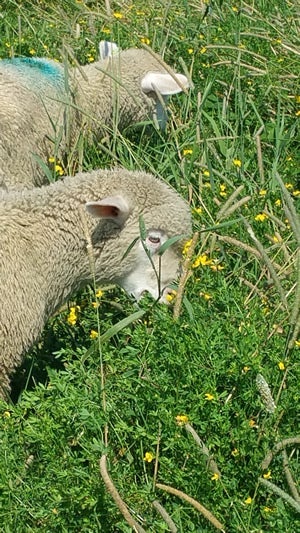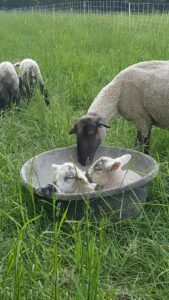Overcoming barriers to transitioning small ruminants to organic production – USDA NIFA Organic Transitions Program
Birdsfoot Trefoil Project Resources
Birdsfoot Trefoil Project Events
About this project:
Click HERE for project flyer. Gastrointestinal nematode (GIN) parasites, such as the barber pole worm (Haemonchus contortus), are a serious problem affecting small ruminant production throughout the Northeast region and world. These parasites are a primary concern when raising sheep and goats on pasture, and cause poor growth, anemia, and death in severe infections. Organic sheep and goat producers are hindered by a lack of alternatives to synthetic dewormers. In addition, the costs associated with organic feed concentrates that are often necessary to promote sufficient growth rates in lambs and kids compromised by parasite infection pose another significant challenge.

Consumption of specific forages containing condensed tannins (CT) has been effective in suppressing GIN infection and providing adequate parasite control in some regions of the U.S. The use of CT forages and other rotational grazing practices are promising methods for maintaining sheep and goat health and profitability in keeping with organic production principles.
This project builds on a recent USDA National Institute of Food and Agriculture (NIFA) Organic Research and Extension Initiative (OREI) Project, “Forage-Based Parasite Control in Sheep and Goats in the Northeast U.S.” That project (August 2012-2017) joined several land grant university researchers, educators, and farmers together to research, demonstrate and evaluate the potential of Birdsfoot trefoil (Lotus corniculatus L.) to suppress GIN parasites in the Northeast. That project demonstrated that the benefits of grazing Birdsfoot trefoil (BFT) were significant and justified additional research.
Left Photo: Sheep grazing Birdsfoot trefoil, Cornell Cooperative Extension Learning Farm, Canton, NY. July 2015. Photo courtesy of Conor McCabe, Cornell University.
Birdsfoot trefoil and condensed tannin forages
Condensed tannins (CT), also called proanthocyanidins, are naturally occurring plant compounds that significantly affect the nutritional value of forage by forming complexes with proteins, carbohydrates and minerals. Tannins, in low to moderate concentrations, can provide other animal health benefits in addition to observed anti-parasitic effects.
Birdsfoot trefoil (Lotus corniculatus L.) is a CT forage that is well suited to Northeast Growing conditions. It is a legume that minimizes bloat, improves protein uptake and has other environmental benefits in addition to possible anti-parasitic effects. Other promising CT legume forages include Sanfoin (more suited to the western U.S.) and Sericea lespedeza (does not over-winter well in colder climates).
Preliminary Results USDA NIFA OREI Project:
During the recent USDA NIFA OREI project, Northeast Farmers demonstrated that they could establish and graze pastures with a BFT dry matter content of at least 25% or greater. Grazing studies in New York and Maine observed that weaned lambs and goat kids tended to grow faster on BFT pastures than on the conventional control pastures and in many cases showed increased resilience to barber pole worm infections as measured by reductions in FAMACHA© anemia scores and reduced need for deworming. In three years of replicated grazing trials at the West Virginia University Organic Research Farm, over 60% of lambs avoided the need for synthetic dewormers on BFT, compared to only 33% on a control pasture (orchard grass and red clover). However, the studies did not observe the sudden decreases in worm egg counts associated with effective synthetic dewormers. More research is needed to investigate the effects of feeding birdsfoot trefoil to small ruminants in a variety of forms on suppressing GIN parasites and improving animal nutrition, growth and profitability.
USDA NIFA Organic Transitions project objectives (Sept. 2018 – Aug. 2021)

- Evaluate agronomic practices to improve Birdsfoot trefoil (BFT) establishment in existing pastures. West Virginia University (WVU) Organic Research Farm
- Field-scale grazing trials to evaluate efficacy of BFT pastures to increase tolerance to GIN parasites, as well as replace or minimize grain supplementation. WVU Organic Research Farm
- Determine the effect of drying method, stage of harvest and storage on the in vitro anti-parasitic efficacy of varying cultivars of BFT. University of Rhode Island (URI)
- Demonstrate WVU research on establishing and grazing BFT on four goat or sheep farms in New York State. Cornell University
- Extend research results to organic and conventional sheep and goat producers throughout the Northeast through educational events and media, including project websites: http://blogs.cornell.edu/smallruminantparasites/ and http://web.uri.edu/sheepngoat. Cornell University, URI, WVU
- Evaluate success of outreach activities and assess economic outcomes with project participants. Cornell University
Right photo: WVU Organic Research Farm, courtesy of Dr. James Kotcon, WVU.
[box style=”light-yellow shadow” ]
Birdsfoot Trefoil Project Resources
Birdsfoot Trefoil Project Events
Project partners and contacts:
Cornell University
tatiana Stanton, Ph.D. – tls7@cornell.edu
Michael Thonney, Ph.D. – mlt2@cornell.edu
Dept. Animal Science
West Virginia University
Jim Kotcon, Ph.D. – jkotcon@wvu.edu
Div. of Plant and Soil Sciences
University of Rhode Island
Rebecca Brown, Ph.D. – brownreb@uri.edu
Dept. Plant Sciences and Entomology
Katherine Petersson, Ph.D. – kpetersson@uri.edu
Elizabeth Kass – urisheepandgoat@etal.uri.edu
Dept. Fisheries, Animal and Veterinary Science
[/box]
[hr color=”dark-gray” width=”100%” border_width=”4″ ]
This material is based upon work supported by the National Institute of Food and Agriculture, U.S. Department of Agriculture, Organic Transitions Program under Agreement No. 2018-51106-28777.

